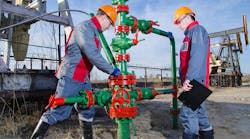Arc Rating–Value describing a fabric’s performance in electrical arc discharge tests that determine how much energy can pass through the fabric before there is a 50 percent probability of second-degree burns.
Base Layer–Clothing worn underneath primary FR clothing should also be flame-resistant for added safety.
Char Length –A measurement used to assess FR clothing performance based on the amount of damaged fabric when a Vertical Flame Test (ASTM D6413) is performed.
Denim –Contrary to common misconceptions, regular denim does not offer sufficient protection against hazards such as arc flash and flash fire — but comfortable FR options are now available in a variety of popular styles.
Energy Break-Open Threshold (EBT)–The amount of incident energy required for a fabric to break open; one of two ways to express arc rating (the other way is ATPV).
Flame Resistant (FR)–A fabric or product that resists ignition and self-extinguishes after removal of the ignition source.
General Duty Clause–OSHA section 5(a)(1), a clause under the Occupational Health and Safety Act that requires employers to furnish each employee with a place of employment free from recognized hazards that cause or are likely to cause death or serious physical harm.
Heat Stress–Choosing FR clothing made from lightweight, breathable fabrics can help reduce heat stress.
Inherent Flame Resistance–Describes FR fabrics that are flame resistant due to the chemical structure of the fibers.
Jackets–All jackets and other outerwear worn over an FR uniform should also be flame resistant.
Knits – FR knit fabrics are known to offer an exceptional level of comfort.
Lightweight–Lightweight fabrics, especially those that also offer good breathability, are often more comfortable than other options — but before choosing a garment made from lightweight fabric, it is important to ensure that it still offers the necessary levels of FR protection and durability.
Multi-Hazard Protection–FR products that offer improved safety and convenience by simultaneously protecting against more than one hazard (e.g., combined protection against flash fire, arc flash and molten metal splatter; FR protection mixed with high visibility; or FR protection combined with chemical-splash protection).
National Fire Protection Association (NFPA)–Publishes standards related to protection against various hazards, such as NFPA 2112 for flash fire and NFPA 70E for electric arc flash.
Occupational Health and Safety Administration (OSHA)–Sets and enforces safety regulations, including several related to FR clothing, in an effort to ensure a safe and healthy work environment for all employees.
PPE Category–Under NFPA 70E, personal protective equipment (PPE) like FR clothing is assigned to one of four categories based on the level of electric arc flash energy exposure it protects against.
Quality Management System–A quality assurance program that monitors product quality through well-documented inspection and testing procedures, and includes criteria for acceptance, rejection, handling of nonconforming materials and material recalls throughout the manufacturing process (e.g., an ISO 9001 certified quality management system).
Repair–When repairing FR clothing, always use FR thread, FR components (e.g., buttons and zippers) and repair patches made from the same FR fabric as the original garment—and if the garment is excessively worn or has rips to large to be patched, replace it instead.
Safety Standards–Organizations such as OSHA, NFPA, ASTM International and others publish regulations and standards that outline best practices related to FR clothing; adhering to these best practices helps promote safety and prevent costly fines.
Thermal Protective Performance (TPP)–A fabric’s TPP is determined by the amount of heat it takes to pass through the fabric and cause a second-degree burn.
UL Certified–UL is a third-party organization that offers certification for FR garments that meet or exceed key standards, such as NFPA 2112.
Vertical Flame Test–Also known as ASTM D6413, this is a standard test method for measuring the flame resistance of textiles based on after-flame time, after-glow time and char length.
Wear Trials–Every workplace has different needs, and perceptions of FR clothing comfort and functionality can vary from person to person, so it is often a good idea to do a wear trial before purchasing FR workwear.
XS, XL, 2XL, 3XL, etc.–FR clothing must fit properly to provide the best protection, so be sure to order the right size garment for each worker and, if necessary, work with a manufacturer to get custom garments made in non-stock sizes.
Yoke–In FR clothing (and non-FR clothing), a yoke is a shaped section of fabric that forms part of a garment (often around the neck and shoulders or the hips) and provides support and structure for the rest of the garment, influencing fit and appearance.
Zippers–Zippers, as well as buttons, snaps and other components, should always be made from FR or high-temperature resistant materials, and FR garments should be constructed in a way that keeps any metal components from coming into contact with the skin.
While this A to Z list is a strong foundation, there is plenty more you should know about FR clothing. For additional information, consult the NFPA standards and OSHA regulations relevant to your workplace. You may also wish to collaborate with a knowledgeable workwear manufacturer to identify the types of FR clothing best suited for your needs.
